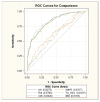High Tg/HDL-Cholesterol Ratio Highlights a Higher Risk of Metabolic Syndrome in Children and Adolescents with Severe Obesity
- PMID: 35956105
- PMCID: PMC9369869
- DOI: 10.3390/jcm11154488
High Tg/HDL-Cholesterol Ratio Highlights a Higher Risk of Metabolic Syndrome in Children and Adolescents with Severe Obesity
Abstract
Few data are currently available on the reliability of the different anthropometric, instrumental and biochemical indexes in recognizing the presence of metabolic syndrome (MetS) in children and adolescents with severe obesity. Therefore, the objective of our study was to find out the simplest and most accurate predictive index of MetS in this population at-risk. In 1065 children and adolescents (563 f, 502 m), aged 14.6 ± 2.1 years (range 10-17), with severe obesity [BMI-SDS 3.50 ± 0.36 (range 3.00-5.17)], the following indexes were evaluated: BMI, BMI-SDS, Tri-Ponderal Mass Index, Waist-to-Height ratio, TG/HDL-Cholesterol ratio, Cardiometabolic Index (CMI), and Visceral Adiposity Index (VAI). For each subject, all the components of MetS, defined according to the IDF criteria, were determined. Overall, the presence of MetS was found in 324 patients (30.4%), 167 males (33.3%) and 157 females (27.9%). According to the ROC analysis, three indexes (VAI, CMI and TG/HDL-Cholesterol ratio), performed significantly better than the other ones in identifying MetS, with no difference among them. In conclusion, the TG/HDL ratio, which just needs the evaluation of two simple biochemical parameters, offers the same accuracy as other more sophisticated indexes in recognizing MetS in children and adolescents with severe obesity, thus making it the best predictor to be easily used.
Keywords: adolescents; children; indexes; metabolic syndrome.
Conflict of interest statement
The authors declare that they have no conflict of interest.
Figures



References
-
- NCD Risk Factor Collaboration (NCD-RisC) Worldwide trends in body-mass index, underweight, overweight, and obesity from 1975 to 2016: A pooled analysis of 2416 population-based measurement studies in 128·9 million children, adolescents, and adults. Lancet. 2017;390:2627–2642. doi: 10.1016/S0140-6736(17)32129-3. - DOI - PMC - PubMed
-
- World Health Organisation (WHO) Obesity and Overweight. 2021. [(accessed on 24 January 2022)]. Available online: https://www.who.int/news-room/fact-sheets/detail/obesity-and-overweight.
Grants and funding
LinkOut - more resources
Full Text Sources
Miscellaneous

